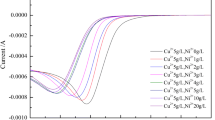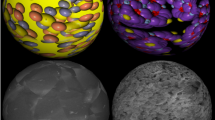Abstract
The anodic dissolution of Cu2S in sulfuric acid solutions was studied under galvanostatic and potentiostatic conditions. The anodic products were studied by mineralogical and X-ray diffraction methods. In every case, the formation of a digenite Cu1-8S layer is observed at the surface of Cu2S according to 5Cu2S → 5Cu1.8S + Cu++ + 2e A copper concentration gradient appears through the digenite layer whose thickness remains constant as soon as a Cu1.1S layer appears at its own surface according to 3Cu1.8S → 4Cu1.1S + Cu++ + 2e If the electrolysis conditions are such that the anodic potential remains low, the next reaction to occur is 10Cu1.1S → HCu++ + 10S + 22e But if under galvanostatic conditions, the current density is high enough at a given temperature to reach the sharp rise in anodic potential, or if under potentiostatic conditions the potential is kept high, two other reactions are possible: 10Cu1.1S → 10CuS + Cu++ + 2e followed by CuS → Cu++ + S + 2e Moreover, at high anodic potential, the following reaction occurs also to some extent CuS + 4H2O ↦ Cu++ + SO4 = + 8H+ +8e resulting in a decrease in anodic current efficiency for the copper dissolution.
From a more practical point of view, it was shown that it is possible to deplete virtually completely the copper content of the anode (residue at less than 0.5 pct Cu)keepingthe electrode potential at a low value (less than +650 mV/ENH). Providing the temperature is high enough (75°C at least), the mean current density remains near to 2 A/dm2, a suitable value to obtain good cathodic deposits.
Similar content being viewed by others
References
E. Marchese: German Patent, 22,429 (1882).
H. O. Hoffman and C. R. Hayward:Metallurgy of Copper, 2nd Ed., McGraw Hill, New York, 1924.
A. G. Loshkarev and A. F. Vozisov:Zh. Prikl. Khim., 1953, vol. 26, pp. 55–62(Chem. Abstr., 1953, vol. 47, p. 6795b).
S. Venkatachalam and R. Mallikarjunan:Trans. Ins. Mining Met./Sect. C, 1968, vol. 77, PP.C45–52.
F. Habashi and N. Torres-Acuna:Trans. TMS-AIME, 1968, vol. 22, pp. 53–64.
V. Kuxmann and H. Biallass:Erzmetall., 1969, vol. 22, pp. 53–64.
P. Cavalotti and G. Salvago:Electrochim. Metal, 1969, vol. 4, pp. 181–210.
G. Thomas, T. R. Ingraham, and R. J. C. Mac Donald:Can. Met. Quart., 1968, vol. 6, pp. 281–91.
J. Dahms, J. Gerlach, and J. Pawlek:Erzmetall, 1967, vol. 20, pp. 203–08.
D. M. Chizikov and B. Z. Ustinski:Izv. Akad. Nauk SSSR, Otd. Techn. Nauk, 1948, pp. 229–34(Chem. Abstr., 1948, vol. 42, pp. 6675i.) and 1949, pp. 1481–92.Zh. Prikl. Khim., 1949, vol. 22, pp. 1249–52(Chem. Abstr., 1950, vol. 44, pp. 3816i) and 1956, vol. 29, pp. 1129–31 (Chem. Abstr. 1956, vol. 50, p. 16474h.)
W. Noddack and K. Wrabetz:Z. Elektrochem., 1955, vol. 59, pp. 96–102.
W. Noddack, K. Wrabetz, and W. Herbst:Z. Elecktrochem., 1955, vol. 59, pp. 752–55.
K. Wrabetz:Z. Elektrochem., 1956, vol. 60, pp. 722–31.
P. Ruetschi and R. F. Amlie:J. Electrochem. Soc., 1965, vol. 112, pp. 665–70.
M. Sato:Econ. Geol., 1960, vol. 55, p. 1202.
M. A. Klochko and M. E. Mironova:Izv. Sekt. Fiz. Khim. Anal, Inst. Obsch. Neorg. Khim, Akad. Nauk SSSR, 1954, vol. 25, pp. 128–33, (Chem. Abstr., 1955, vol. 49, p. 14527h; 1955, vol. 26, pp. 68–75 and 75–81. (Chem. Abstr., 1956, vol. 50, p. 2320a).
S. H. Cole and P. Duby: Columbia University, New York, Unpublished research, 1971.
H. J. Mathieu and H. Riekert:Z. Phys. Chem., Neue Folge, 1972, vol. 79, pp. 315–30.
A. Etienne and E. Peters:Trans. Inst. Mining Met./Sect. C, 1972, vol. 81, pp. 176–81.
Author information
Authors and Affiliations
Additional information
Former assistant and student respectively, in the Department, are Chemical Engineers.
Rights and permissions
About this article
Cite this article
Brennet, P., Jafferali, S., Vanseveren, JM. et al. Study of the mechanism of anodic dissolution of Cu2S. Metall Trans 5, 127–134 (1974). https://doi.org/10.1007/BF02642936
Received:
Published:
Issue Date:
DOI: https://doi.org/10.1007/BF02642936




